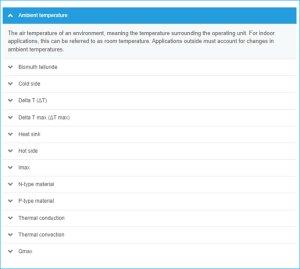Thermal Glossary
Welcome to the Laird Thermal Systems thermal glossary.

Quick Links
The air temperature of an environment, meaning the temperature surrounding the operating unit. For indoor applications, this can be referred to as room temperature. Applications outside must account for changes in ambient temperatures.
Semiconductor material commonly used for Thermoelectric Coolers at temperatures between 0 and 200⁰C.
The side of the Thermoelectric Cooler Module that is normally in contact with the system or device that is being cooled. When the Thermoelectric Cooler is connected to DC Power, the cold side will absorb the heat.
The temperature differential between the hot and cold side of a thermoelectric cooler or assembly.
The maximum temperature differential that can be reached at a given temperature of the hot side of the thermoelectric cooler under no load, Qc=0
Works as a thermal conductor by absorbing heat or radiating to surrounding environment.
The side of the Thermoelectric Cooler Module that is dissipating heat to the heat sink. When DC power is connected to the Thermoelectric Cooler, the hot side will reject the heat to the surrounding environment
The maximum current (Amps) at ΔT max.
A type of extrinsic material where the dopant atoms are capable of providing extra conduction electrons to the host material, creating an excess of negative (n-type) electron charge carriers.
A type of extrinsic material where the dopant atoms are capable of providing extra acceptors (lacking electrons) to the host material, creating an excess of positive (p-type) hole charge carriers.
The flow of heat within a solid material caused by a temperature differential of the cold and hot side of a unit.
Refers to heat transfer by movement of molecules in liquids or gases such as air.
The maximum heat pumping capacity rating at ΔT=0 and Imax

